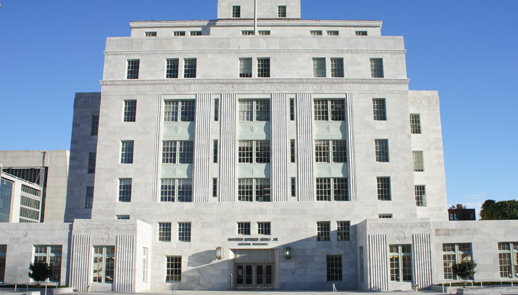GSA’s New Regional Home in Atlanta Honors Past, Looks to Future
|
By Gregory Andrews ATLANTA, Jan. 13, 2011 – At 11 a.m. on a crisp fall morning in 1933, dignitaries extolled the many virtues of the magnificent and imposing new U.S. post office in Atlanta. Commentators questioned whether a building, even one as grand as this, could justify the $3 million price tag. Organizers of the ceremony fretted over whether it would conclude on time so attendees would not miss the kickoff for the Georgia Tech vs. Duke football game later that day. Three years before and four miles away, Martin Luther King Jr. was born on Auburn Avenue on Jan. 15. In the decades since these two events, much has changed in Atlanta and the world. The building has stood as a silent observer as countless structures have been built, torn down, and built again. In like manner, Dr. Martin Luther King Jr. brought down the walls of discrimination and gave the nation and the world the blueprint to the creation of a society based on justice and human dignity. On Jan. 14, the Martin Luther King Jr. Federal Building, the first federal facility named for the civil rights leader, will officially reopen at a 1 p.m. ceremony. Guest speakers include U.S. Rep. John Lewis and Administrator of General Services Martha N. Johnson. As the post office, the facility served as the mail processing center for 35 years. In 1983, the GSA acquired the facility from the U.S. Postal Service; in 1988 it became the first federal building to the bear name of the famous civil rights leader. It has served as home to a variety of federal agencies, including Homeland Security, FBI, and Immigration and Customs Enforcement. In 2003, GSA committed to restoring the building. In doing so, the agency also committed to restoring the structure with an eye toward incorporating the best practices in historic preservation and sustainable design. The project is a fusion of rehabilitation, preservation, recreation, and sustainable design. The integration of new technology into historic buildings is the key to giving new life to an older building by making it use by today’s standards. The project began with a major renovation of the building’s exterior. About 6,000 façade stones were removed, tagged, and cataloged for precise replacement in their original location. All windows were stripped of lead-based paint and repainted inside and out; 106 were rebuilt, replaced and resealed. The original roof was replaced with an insulated roofing system, provided with white marble ballast to meet the Leadership in Energy and Environmental Design standard for reflectivity. Other sustainable design and historic preservation features include:
The choice of artwork celebrates the buildings dual heritage. Enlarged images of postal stamps are used throughout the building, serving as a colorful reminder of its original function as the central postal facility for the city. The main entrance to the building features a dramatic backlit image of King; the main corridor contains a moving and inspiring gallery of photographs chronicling the life and time of the great civil rights leader. This building is so much more than stone and steel. It is the physical manifestation of a collective history. Born in the Great Depression, it has endured through times of prosperity and challenge, and it prospers yet again today, thanks to GSA. Future generations will climb its granite steps and know that those who came before preserved this places for all the generations to come.
|
 |
| The Martin Luther King Jr. Federal Building in Atlanta was first dedicated to the civil rights leader in 1988. During recent renovations, each of the roughly 6,000 exterior stones was removed and tagged for accurate replacement. The 78-year-old Atlanta building will house GSA's Southeast Sunbelt Region employees. |




